by Julie McConnell | Apr 13, 2015

New foliage of Japanese Plum Yew Photo credit: Julie McConnell, UF/IFAS
Trying to grow turfgrass in shaded areas is a losing battle but that doesn’t mean you have to settle for mulch in those dark areas of the landscape. There are many plants that will tolerate shady conditions found under the canopy of large trees, and some offer year round interest!
One of the most important aspects of site assessment is sun exposure. Plants need light, but do not all need the same amount or intensity.
If plants requiring full sun are planted in the shade, they tend to get leggy and do not flower well. Although they may live, they will not perform at their peak.
Shade loving plants grown in the sun may be stunted, show leaf scorch, and will struggle. Most shade plants can tolerate some filtered light or morning sun, but need to be protected from direct mid-day to afternoon sun.
So, what evergreen plants can add some color and texture to your shaded spots?

Golden tones of new foliage is what gives Autumn Fern its common name. Photo credit: Julie McConnell, UF/IFAS
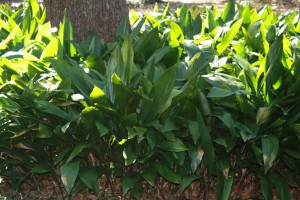
Cast Iron Plants under a live oak tree. Photo credit: Julie McConnell, UF/IFAS

Japanese Plum Yew. Photo credit: Julie McConnell, UF/IFAS
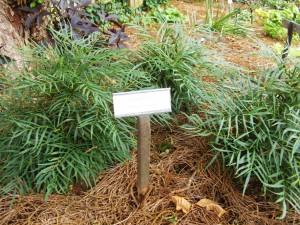
Soft Caress Mahonia. Photo Credit: Julie McConnell, UF/IFAS
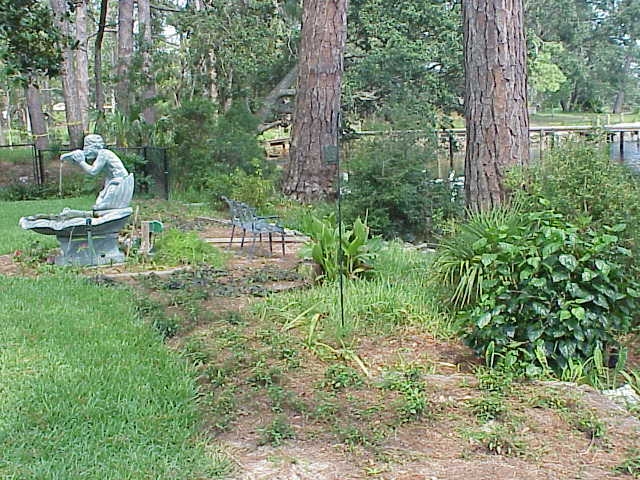
by Carrie Stevenson | Mar 17, 2015
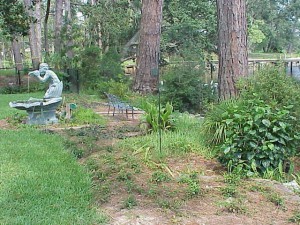
A waterfront buffer zone may include a raised berm with native vegetation to slow runoff from a yard before entering the water. Photo credit: Carrie Stevenson
A taste of spring weather has arrived, and people will soon be filling the home improvement stores and getting ready for outdoor projects. If you live on the water or near a storm drain, it’s worth considering buffer zones and best management practices for fertilizing and lawn maintenance.
A waterfront buffer zone is an area the length of one’s property line, typically running about 10 feet (although it can be wider) from the edge of a shoreline (or even a storm drain) into the yard. In this area, the homeowner allows native vegetation to grow along the water and uses low-maintenance plants within the buffer. In this zone, no fertilizers or pesticides are used. Some homeowners will build a small berm to divide the area of maintained lawn (uphill) from the downhill waterfront side. This berm may be composed of a mulched area with shrubbery to catch and filter runoff from the more highly maintained lawn. This combination of actions helps treat potentially polluted stormwater runoff before it reaches the water, and keeps homeowners from using chemicals close to the water. It is often quite difficult to grow turf next to the water, anyway, and this takes the pressure off of someone trying to grow the perfect lawn down to the water’s edge. The buffer zones are often quite attractive and can be an excellent transition between managed turf and the waterfront.
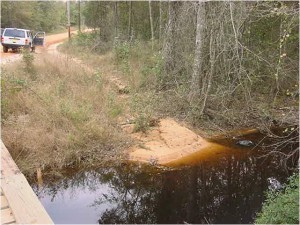
Unmaintained dirt roads along creeks are significant sources of sediment, which can harm the bottom-dwelling insects that form the base of the food web. Photo credit: Carrie Stevenson
Erosion prevention is crucial along waterways, as well. An open, non-vegetated lot can contribute a significant amount of sediment to a storm drain, stormwater pond, or natural body of water. Whether grass, trees, or bushes, any kind of vegetation is preferable to soil washing out of a yard and into the water. Sediment is a problem because it causes water clarity to drop, which can prevent seagrasses from getting the sunlight they need. Once settled, underwater sediment can form a stifling layer that chokes out small insects and invertebrates, which live in the soil and form the basis of the aquatic food chain. With no fish food available, fish may die or move out of an area. The most dramatic examples of this can often be found at dirt roads that cross over creeks. If not managed properly, the clay on these roads can nearly bury a small stream.
Other lawn care techniques for protecting the waterfront and preventing stormwater pollution include not mowing along the water, using a deflector shield and staying 3’-10’ away from the water’s edge when fertilizing, and not allowing grass clippings to blow into storm drains. Large amounts of decaying grass in a waterway can use up available oxygen, endangering aquatic organisms. When applying granular fertilizer, be sure to sweep up any spills on concrete so it doesn’t run into a storm drain. When cutting grass, mow at the highest height recommended for your turf to encourage deep rooting and stress tolerance. Healthy turf is better able to withstand drought, pests, and choke out weeds, reducing the frequency of pesticide and water application.
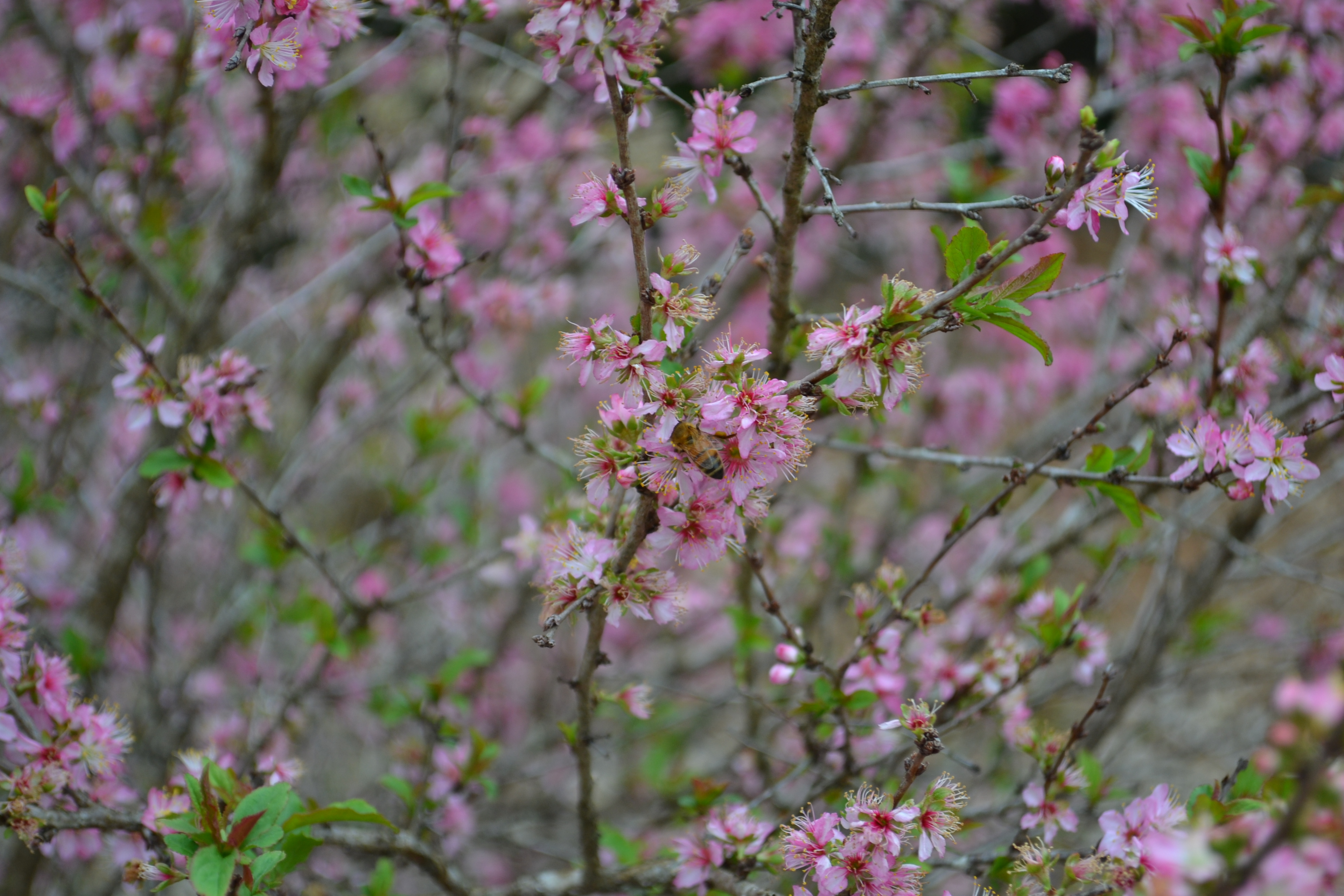
by Beth Bolles | Mar 10, 2015
Although we are not able to grow edible cherry trees in more southern climates, there are a few ornamental relatives of the cherry that are worth adding to the landscape. The Bush cherry, Prunus jacquemontii, is an attractive deciduous shrub that is a highlight with pink blooms in late winter. Flowers provide an early nectar source to bees.
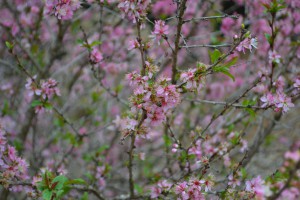
Bees are actively visiting flowers.
Plant the bush cherry is an area that receives sunlight and allows for the rounded shrub to grow about 5 feet by 5 feet. Plants like well-drained soil but benefit from some moisture during the growing season. Small berries serve as a food source for wildlife and can be used in jellies and jams. Leaves turn yellow in the fall before dropping. Plants are generally low maintenance and certainly brighten winter days. 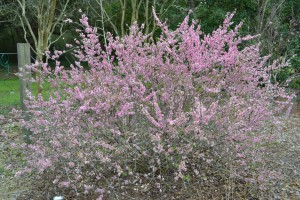
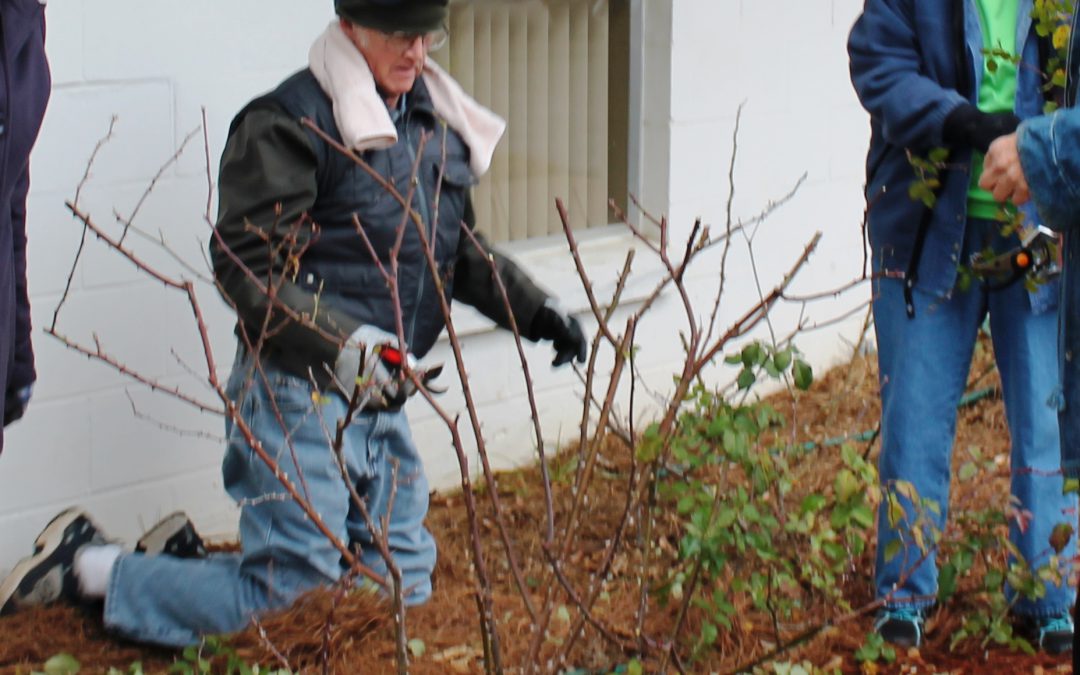
by Matthew Orwat | Mar 3, 2015
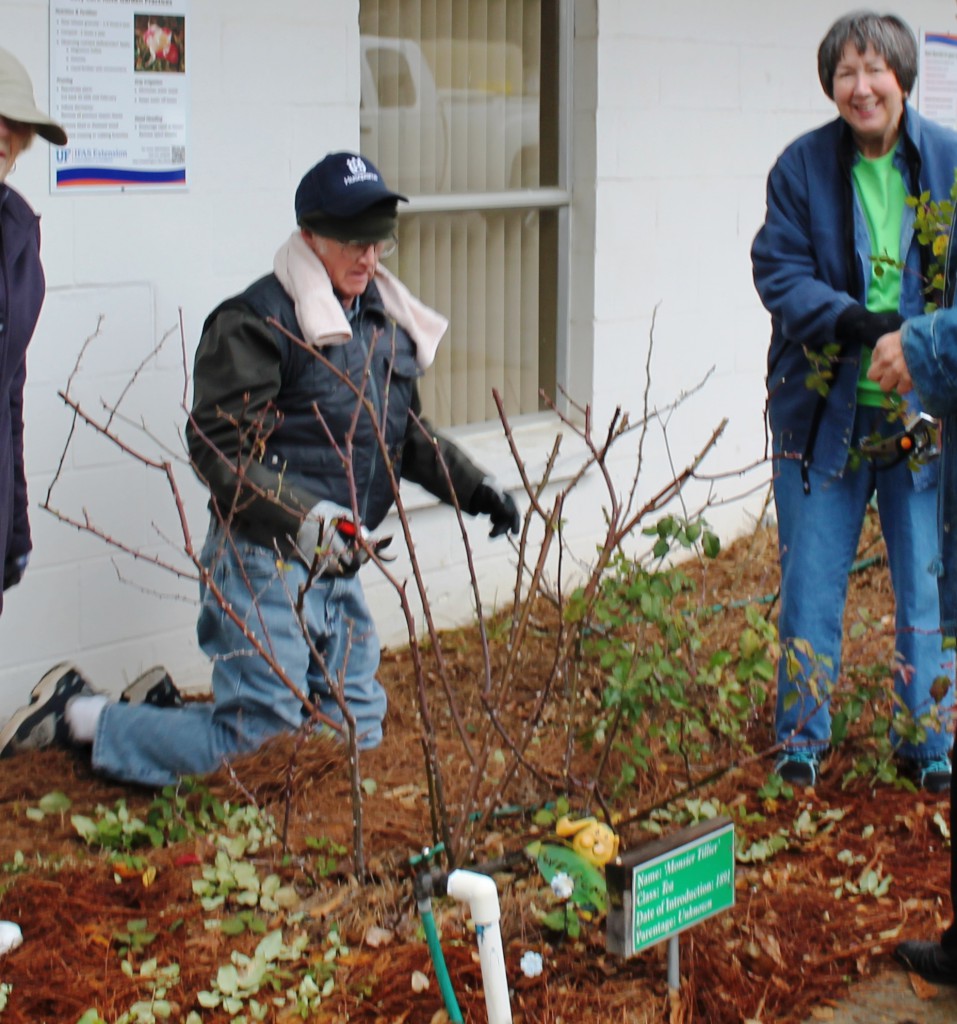
The process of pruning roses. Image Credit Matthew Orwat
Many rose enthusiasts ask every season? When do I prune my roses? The general recommendation is February 15th. If that recommendation is followed it’s usually not harmful, though climate can be very different from the coast to the state line . Therefore, my typical answer is to advise gardeners to prune roses when the Azaleas are in bloom. Typically, Azaleas are in full bloom or have finished blooming by the beginning of March. In many areas of the Florida Panhandle this year, they have not started due to late season freezes.
March 1st it is time to prune repeat blooming roses regardless of the condition of the Azaleas, so that gardeners will enjoy a few spring bloom cycles before the heat sets in.
When pruning roses there are several factors that need to be considered. First is the type. Is the rose a Hybrid Tea, Floribunda, Old Garden Rose, Shrub or Climber? Is it once blooming or repeat blooming? Once blooming roses and many repeat blooming climbers perform best if pruned after the spring display. This ensures the largest amount of bloom possible.
Hybrid Teas, Floribundas and their ilk are usually pruned back at least by half, keeping the strongest 4-8 canes and removing old, diseased, damage or non productive wood near the base or juncture of a large cane.
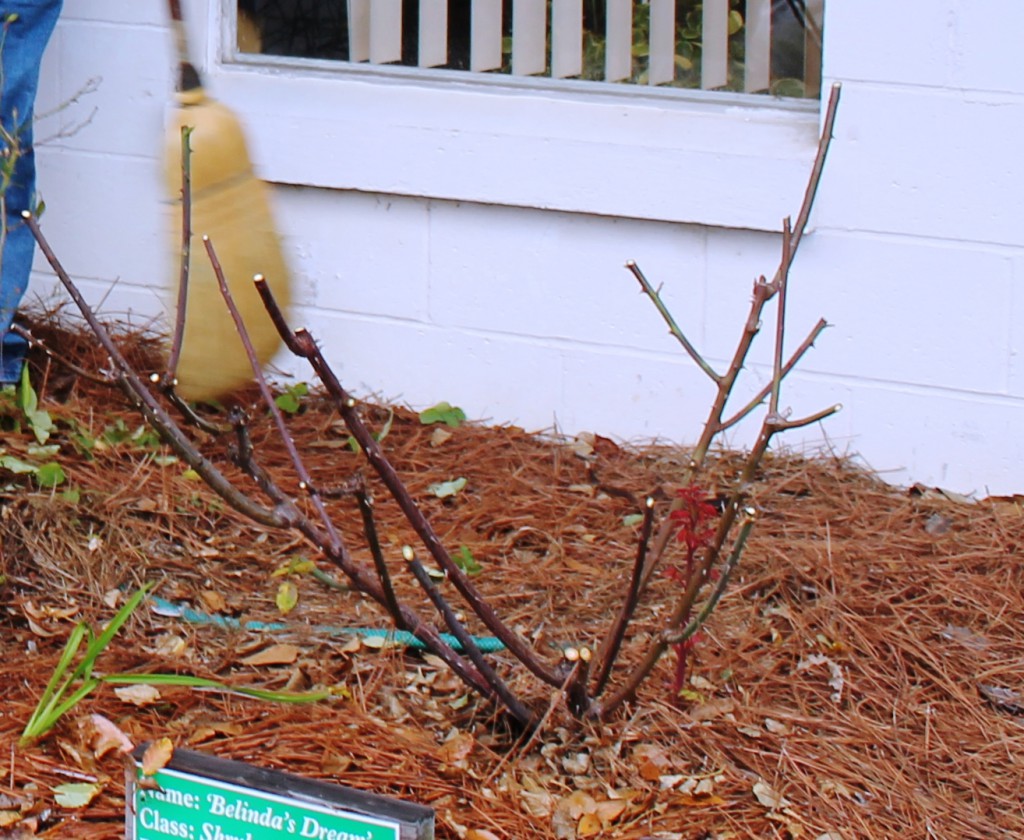
Typical “light” pruning of a Hybrid Tea or Floribunda. Image Credit Matthew Orwat
Old garden roses are seldom pruned hard. The best method in pruning old garden roses is to remove dead, old or unproductive wood, and eliminate crossing branches and excessive inward growth. This opens up the plant and allows for increased airflow, which reduces disease incidence. Once the plant has been “opened up” it may be pruned back by 1/3 to 1/2. Pruning back Old Garden Roses by 1/3 to 1/2 is not necessary but is often done for space considerations.
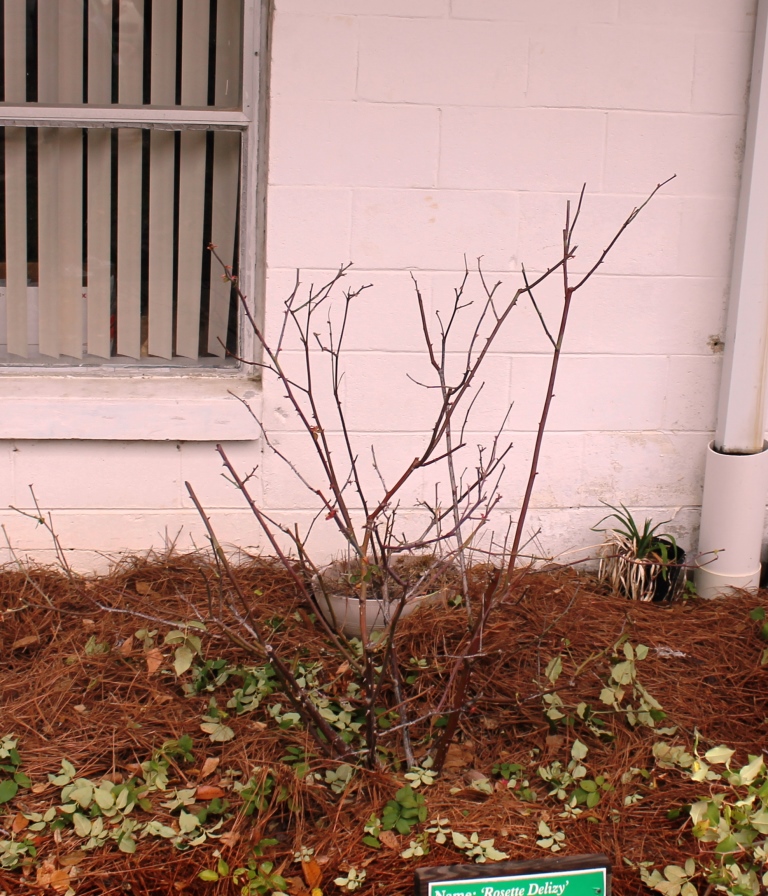
A lightly pruned old garden rose. Image Credit Matthew Orwat
Many Shrub Roses, such as Knockout, and various Old Garden Roses are trimmed several times a year with hedge trimmers. This is often the only pruning done except for the annual removal of dead or non-productive wood.
Additionally, roses benefit from the removal and disposal of any remaining leaves after the completion of late winter pruning. This helps reduce disease carry over from the previous year and induces a short dormant period.
Along with pruning it is often advantageous to spray with a dormant fungicide spray, such as Lime-Sulfur. This can be found at farm supply stores or nurseries and must be applied according to label directions. It is especially important to cover the skin when using this product, since the sulfur component is caustic to skin in its concentrated form. It will also burn any new growth, so it can only be used during the dormant season.

by Mary Salinas | Mar 2, 2015
The sight and sound of birds in the yard reconnects us to the wonder and beauty of nature. Providing food, water and shelter can bring the joy of our feathered friends into outdoor spaces.
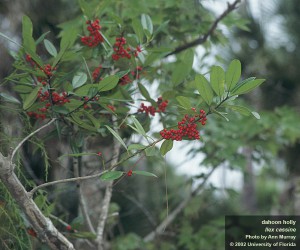 Leave behind the standard palette of trees and shrubs that characterize many urban landscapes. Rather, choose trees and shrubs that provide food and shelter to birds. Here are just a few to consider:
Leave behind the standard palette of trees and shrubs that characterize many urban landscapes. Rather, choose trees and shrubs that provide food and shelter to birds. Here are just a few to consider:
Hawthorns – The thorniness of these trees provide excellent protection for birds nesting in their strong branches. In spring, their abundance of blooms attracts a wide variety of pollinators. The size of the fruits vary with different species of hawthorn. For instance, the yellow haw (Crataegus flava) has large fruit suitable for larger birds, while the littlehip hawthorn (C. spathulata) produces small fruit for even the smallest of the fruit-eating birds.
Hollies – When most other fruiting trees are bare of fruit in winter, hollies provide abundant berries in the fall and hold them well into winter to provide food for migratory and resident songbirds. Dahoon holly is a versatile tree for many landscape settings, from dry, sunny locations to moist woodlands. It is even moderately salt tolerant.
Viburnums – This family of large shrubs are adaptable to a wide range of landscape situations. The dense foliage and branching provide excellent nesting opportunities for birds. Flowers bloom in spring to summer and are followed by purple fruits in late summer and fall that are enjoyed by many birds.

Songbird at a tube feeder. Photo by Thomas Wright, UF/IFAS.
Do you want to attract birds right away? While you wait for new plantings to mature and provide food, put out a few bird feeders. There are a wide variety from which to choose. Tube, hopper and platform feeders can be filled with a variety of seed mixes. Suet feeders are constructed of a heavy gauge wire and hold a solid cake of animal fat with seeds, nuts, grains or fruits. Nectar feeders cater to hummingbirds. Fruit feeders are made to hold large pieces of fruit, like apples and oranges. The type of feeder and food you offer will determine the species or type of birds you will attract.
Don’t forget a bird bath. Birds need a clean water source, so remember to rinse it on a regular basis.
Think twice about attracting birds, though, if you let your cats run free. Cats are dangerous to our bird populations. But if they are strictly housecats, they will love to watch the birds through the windows or porch screens as much or even more than you will.
For more information:
U.S. Fish & Wildlife Service: Backyard Bird Feeding
Attracting Backyard Birds: Bird Feeder Selection
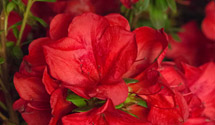
by Sheila Dunning | Feb 3, 2015
Nothing signals spring in the south like the reds, pinks and whites of azaleas in full bloom. Nearly every yard has one. For two weeks out of the year there are flowers everywhere. But the glory fades fast. That was, until the late 90’s.
Twenty-eight Encore® azaleas have been released since 1998. Robert E “Buddy” Lee, an avid collector and azalea breeder from Independence, Louisiana initiated an azalea breeding program to incorporate fall blooming characteristics into a winter hardy, evergreen azalea. He started his work in the 1980s, working out of his home with the goal of bringing the beauty of spring azaleas to other seasons. As the project grew, he eventually teamed up with Flowerwood Nursery to continue the process that would bring Encore® azaleas to the public. And, this spring number 29, Autumn Fire™ , a true red dwarf will be released, nearly a year ahead of  its original predicted introduction date.
its original predicted introduction date.
Lee selected the seedling that was to be named Autumn Amethyst™ in 1986, but did not receive the plant patent until 1998. So far, there are two series of Encore® azaleas: the Autumn series and the Southern series. The Autumn series can be grown in Zone 7 or warmer. The Southern series was designed for even warmer climates; they can be grown in Zone 8 or warmer. The Southern varieties are especially good for the Florida panhandle and the Mississippi and Alabama gulf coasts.
Different parents were used for the various cultivars now available. The fall flowering trait primarily comes from Rhododendron oldhamii Fourth of July – a cultivar selected from seed collected in 1968 at 2,500 feet up Taiwan’s Mount Tai Tun. The female parent used to create Autumn Amethyst™ was a winter hardy hybrid named ‘Karens’ a cross between ‘Hinodegini’, the old Kurume variety, and R. yedoensis var. poukhanense, the Korean azalea.
At the 2015 Gulf States Horticultural Expo last week, I got to see Autumn Fire™ in full bloom. It is a bright cherry red with 2.5” blooms, on a nice compact 2.5’ X 3’ dwarf plant. I think it’s a keeper. Encore® azaleas are available in an array of colors, growth forms and bloom characteristics. New hybrids provide the traditional spring display during March and April, but they also bloom again in the fall, usually during September or early October. They reliably bloom in the spring and fall, but are never quite as covered with a complete carpet of flowers as you might see on a traditional azalea.
Encore® azaleas have the same cultural requirements as traditional azaleas. They should have a pH between 5.0 and 5.5, a well drained organic soil and water during the summer months. Bloom is heavier in brighter locations, with areas having morning sun and afternoon shade probably the best. If pruning is required to control size, thin and shear them in the spring just after bloom.



















